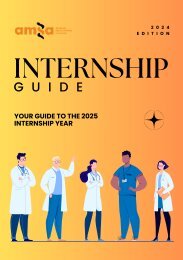AJGH Nexus - Volume 17 2023
AMSA Journal of Global Health (AJGH) 2023 Issue "Nexus"
AMSA Journal of Global Health (AJGH) 2023 Issue "Nexus"
You also want an ePaper? Increase the reach of your titles
YUMPU automatically turns print PDFs into web optimized ePapers that Google loves.
<strong>Volume</strong> <strong>17</strong> | <strong>2023</strong><br />
2.6 Data management and analysis<br />
All data were analysed using SPSS 27. For the<br />
purposes of our analysis, sex was recorded to a<br />
binary variable and the categories “non-binary”<br />
and “prefer not to say” were excluded due to low<br />
numbers. The variables living with a chronic<br />
physical or mental health condition were also<br />
recorded into binary “yes or no”, due to low<br />
numbers in the categories, “don’t know” or<br />
“prefer not to say”. Responses to the question<br />
about the impact on the respondent’s work were<br />
re-organised from five categories to two<br />
categories to create a binary variable of “work<br />
impacted” or “work not impacted.” Common<br />
reasons why people responded “other” to this<br />
question were that they were self-employed, or<br />
their hours had increased due to COVID-19 and<br />
therefore it was decided to place them in the<br />
“work not impacted” group. We acknowledge<br />
that the inclusion criteria and type of<br />
employment options in our study did not capture<br />
unpaid or care-giving work.<br />
For the initial analysis, responses to the worry<br />
scale were translated from the 9-point scale into<br />
3 level-of-worry categories, based on a version of<br />
the survey distributed as part of a study in<br />
Ethiopia.[15] From the 1-9 scale, scores of 1-3<br />
were interpreted as “Don’t worry at all”, scores<br />
of 4-6 as “Worry somewhat” and scores of 7-9 as<br />
“Worry a lot”. The 3 levels of worry categories<br />
were designated a score of “Don’t worry at all” =<br />
1, “Worry somewhat” = 2 and “Worry a lot” = 3 for<br />
individual questions which were summated for<br />
an individual’s total worry score.<br />
The proportion of participants in each level of<br />
worry for each question was then re-analysed<br />
according to various demographic factors. These<br />
features were sex (male or female), industry of<br />
primary paid employment (healthcare or other),<br />
living with a chronic physical health condition<br />
(yes or no), living with a chronic mental health<br />
condition (yes or no), living alone or with others<br />
and work impacted by COVID-19 (yes or no). An<br />
independent sample t-test and a chi-square test<br />
for independence were used to compare total<br />
and question specific levels of worry between<br />
groups respectively.<br />
To compare our results to another study that<br />
utilised a similar questionnaire, the total worry<br />
scale was calculated for our 15-question<br />
questionnaire, but then recalculated, omitting<br />
three questions that were not included in the<br />
study of interest for comparison.[15]<br />
Separate multiple regression analyses were<br />
performed to investigate factors predictive for<br />
level of worry about COVID-19. The independent<br />
variables of total DASS21 score, age, sex, preexisting<br />
chronic health condition, living alone or<br />
with others and work impact of COVID-19 were<br />
included in the analysis.<br />
3. Results<br />
3.1 Responses<br />
There were 616 responses to the survey recorded.<br />
This analysis excluded participants who did not<br />
complete all 15 questions on the COVID-19 Worry<br />
Scale, leaving a total of 494 participants.<br />
3.2 Participant characteristics<br />
Participants were predominantly female (80.4%)<br />
with a mean age of 43.6 years. The most common<br />
industries of primary paid employment were<br />
healthcare and social assistance (44.5%) and<br />
education and training (23.7%). Approximately<br />
21.0% reported having a chronic physical health<br />
condition and 20.0% a chronic mental health<br />
condition. No participants in our study reported<br />
ever being diagnosed with COVID-19 nor did any<br />
members of their household.<br />
3.3 Worry scale responses<br />
Worry scale questions are ranked from highest<br />
to lowest level of worry in Figure 1. The top three<br />
worries were “my loved ones’ health”, “economic<br />
recession in my country” and “health systems<br />
being overwhelmed”, with 36.6%, 31.8% and 27.5%<br />
of the cohort respectively reporting a high level<br />
of worry. By contrast, the three questions that<br />
demonstrated the least amount of worry were<br />
“restricted access to food supplies”, “restricted<br />
liberty of movement” and “having to defend a<br />
decision not to attend a social event which my<br />
family and friends expect me to attend” with<br />
only 13.4%, 12.8% and 11.3% respectively reporting<br />
a high level of worry.<br />
04

















